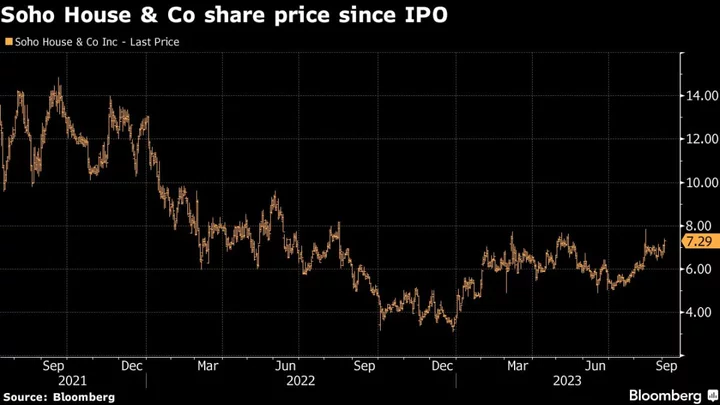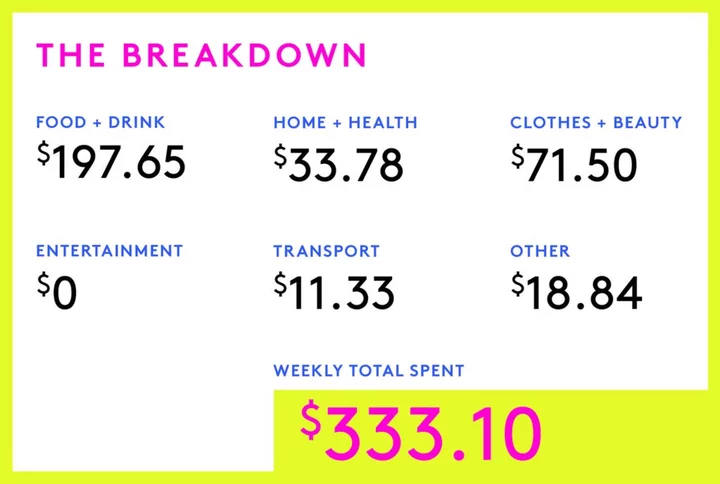Andrew Carnie spotted a curious anomaly in the three New York outposts of his membership club Soho House last year. In August, well-heeled members disappeared to Europe — partly due to companies introducing “work from anywhere August.” This year, the exodus was even greater. “It’s a new trend, especially on the east coast,” he says.
Thankfully for Carnie, who has been chief executive officer of Soho House & Co. since November last year, New Yorkers are also decamping for places closer to home — so much so that the prestigious private club is opening a rural outpost in upstate New York, along with plans for a host more sites across the Americas.
“We’re going to grow in New York and LA, there’s a lot more opportunity there for us, but we see a big opportunity to grow across North America,” says Carnie, in an interview. “There’s a lot of thriving cities in America now, especially post-Covid where a lot of folks moved out of New York and LA, that are brilliantly suited for a Soho House.”
Soho House, which began in London in 1995, opened its first New York club in Manhattan’s Meatpacking District 20 years ago. It now has three in the city, and has launched in Los Angeles, Miami, Nashville and Austin, among others. On Wednesday, Carnie will announce plans to open a further six in the Americas over the next two years, bringing the total — including upcoming houses in Portland and Charleston — to 20 by 2025.
He is also laying out plans for a country-house inspired outpost in Rhinebeck, upstate New York. Grasmere House, as it will be known, is likely to have a lake and a winter-wonderland-inspired Christmas attraction.
Carnie spoke to Bloomberg News at Soho House Dean Street in London ahead of his trip to New York, where he arrived this week to mark the group’s US anniversary. A highlight will include breakfast with staff in New York, cooked by Carnie and Soho House founder Nick Jones. “I always have breakfast with the housekeepers because they’ve been with us so long and it’s good to get the gossip,” says Carnie, settling into an arm chair with a cup of coffee. Soho House’s dress code is casual, and Carnie fits the part in a black T-shirt, trousers and white Nike sneakers.
A House on Wall Street
This week in the US is also a chance to dwell on its life as a public company, two years after Soho House listed on the New York Stock Exchange. After a bumpy period following the IPO, the company narrowed its losses and in second quarter earnings nudged up its annual forecasts as memberships continued to grow. Shares, which halved in the first year post-IPO, are up more than 50% since the beginning of this year.
Carnie says the company floated at a unique time for the market. “We got caught up a bit if we’re being honest around tech,” he says. Coming out of Covid, hundreds of millions of dollars was flowing into platform businesses, with the likes of digital conferencing app Hopin and others achieving rocketing valuations. Soho House, whose parent company changed its name to Membership Collective Group, had sought to become a “global membership platform of physical and digital spaces.”
Earlier this year, the name Membership Collective Group Inc. was dispatched in favor of a return to its roots, becoming Soho House & Co. “I said to Nick, ‘we’ve got to simplify everything here. We’re a membership club’,” Carnie says, admitting that the company’s results were not good enough. “We kept missing our numbers.”
Carnie, who was paid $3.7 million in total compensation in 2022, also scaled back Soho House’s digital plans — at one stage, it was going to launch a digital membership whereby its app could be used for networking, along with streams of content. “We stopped doing a lot of things that our members didn’t care about or didn’t necessarily want,” he says.
Soho House began from a single site above a Soho restaurant, Cafe Boheme, which was run by Jones, now 59. In the years since, houses have opened in London’s trendy Shoreditch, Mumbai and three in New York - Ludlow, Dumbo and Soho House. Today, it has 41 houses across the world, including 10 in London.
Soho House grew popular by being a membership club for the creative classes — those in media, advertising and music — instead of the existing private clubs historically catering for those working in finance or politics. Suits, ties and “corporate attire” are discouraged. Its only dress code is: keep it casual.
Elite Membership
As it grew, the trials of getting a membership seeped into pop culture. Even Samantha, the fictional character in Sex and the City, failed to get through the wait list at Soho House in Manhattan.
Today, Soho House has 176,000 members. A typical member in London pays £2,750 ($3,455) a year, while in New York it’s $4,899 to access the global network of houses. Prospective members are proposed by existing members, and join a wait list (now at 95,000) until they are granted approval.
“We look for great people, creative souls”, Carnie says.
If tabloid newspapers and gossip websites are to be believed, such creative souls have included Prince Harry and Meghan, Justin Bieber and Leonardo DiCaprio. But Carnie insists, without a hint of irony, that the group isn’t exclusive — despite its membership fee. “We don’t really talk about exclusivity that much, we just talk about finding great members,” he says.
Carnie joined Soho House from the fashion brand Anthropologie in 2019, and took over as chief executive from Jones last year. Since then, he’s been on a mission to improve service and streamline costs. Plans to open between eight and 10 new houses a year have been tempered to between five and seven. Sites in Mexico City and Sao Paolo will launch this year, while Manchester, UK, is scheduled for early 2024. A club in Glasgow will follow.
Wealthy Partners
Soho House’s empire also includes furniture retailer Soho Home, Italian restaurant Cecconi’s and The Line chain of hotels, which it bought in June 2021. Soho House & Co. also runs The Ned — a type of Soho House for City workers, which has venues in London, New York and Doha. A fourth venue, with backing from the “junk bond king” Michael Milken, is opening in Washington close to the White House.
Securing backing from wealthy partners such as Milken has become key to Soho House’s business model. It is majority owned by the retail billionaire Ron Burkle, who serves as Soho House & Co.’s executive chairman.
Finding members for new houses begins far ahead of opening. Across Latin America, where Soho House is opening in Mexico City and San Paolo, it already has 15 “Cities Without Houses” where it holds events and dinners for prospective members.
Along with the US and Latin America, Soho House is only just getting started in mainland Europe. It’s opened in Rome, and Carnie is eyeing up Milan. He’s also considering another venue in France, after opening in Paris two years ago. “We know they would like an experience” he says. That could potentially include a French Soho Farmhouse.
The early results appear promising, with Carnie pointing to the last two quarters, where Soho House has beaten expectations. Richard Caring, the restaurant entrepreneur and a shareholder in Soho House & Co., said Carnie had the “international experience and width” to understand the entirety of the business. “It’s the US that we need to improve on,” said Caring. “And Andrew’s doing that. He’s spending time there.”
For clues on where Soho House will open next in the US, Carnie suggests looking “anywhere where there’s a creative community.”









